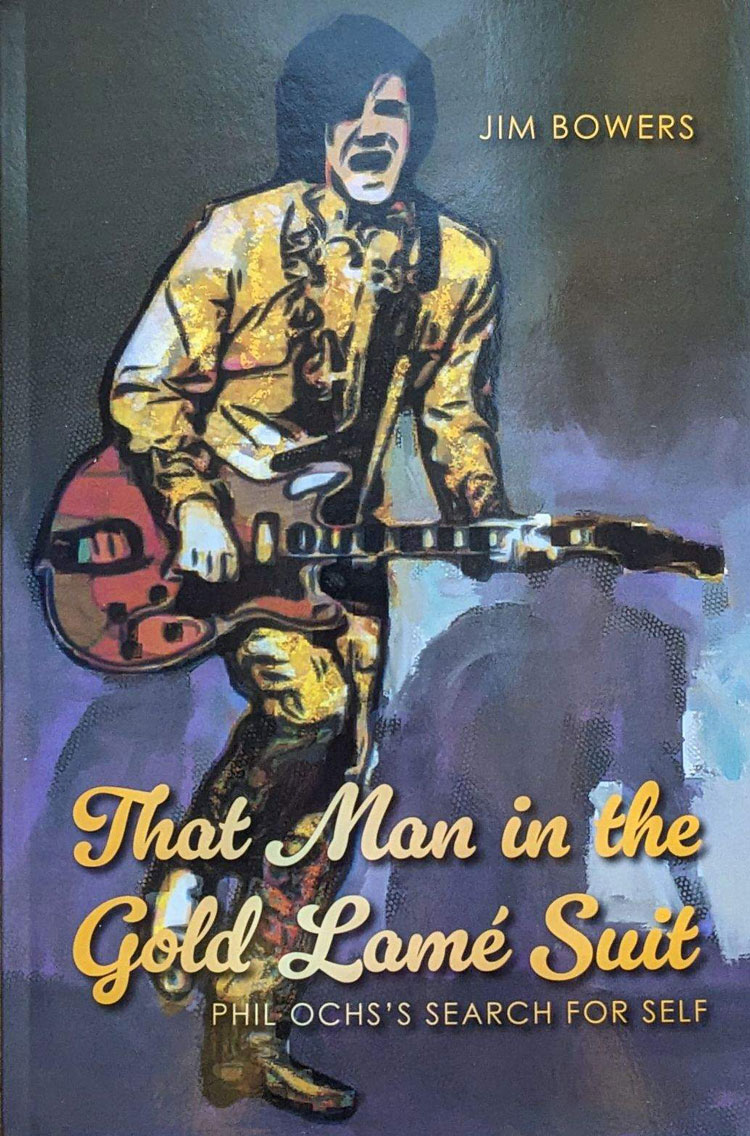That Man in the Gold Lame' Suit
Phil Ochs's Search for Self
by Jim Bowers
On the evening of March 27, 1970 the folk singer Phil Ochs burst on to the stage at Carnegie Hall wearing a gold lamé suit in an ill-fated attempt to merge the revolutionary sensibilities of Che Guevara with the popular music of Elvis Presley. This legendary concert, which came to be known as the gunfight at Carnegie Hall, was both the culmination and the collapse of the popular contemporary protest singer Phil Ochs. What was he thinking? How did he go from the acoustic folkie of "I Ain't Marching Anymore" and "When I'm Gone" to this attempt to amalgamate rockabilly and revolution? As Jim Bowers puts it in his new book "That Man in the Gold Lame' Suit, Phil Ochs's Search for Self "... the psychological connection between artists and their art is a perplexing one."
And why does it matter? What does singer-songwriter Phil Ochs' life and music have to teach us about the world we live in today? As it turns out a great deal. Phil was a master craftsman of songs that grappled unflinchingly with issues that are still very much with us today but also a deeply troubled individual. Addressing illegal and immoral wars, racism, government power and immigration, Ochs didn't just write about these issues but demanded that we acknowledge them and confront our own complicity. Today it is hard to listen to "We Ain't Marching Anymore" without considering its relevance to the US invasion of Iraq or the Russian war in Ukraine and our responsibility to wars' victims.
What is it like to be a brilliant and tormented artist who lives his life on his sleeve? Or in the case of the Ochs, who uses his music, particularly the songs that he writes about social and political issues, as a mechanism to make sense of a world that he sees as misguided, misdirected and ultimately sliding into the abyss. What is the thinking, the influences and the pressures on such an artist? Jim Bowers' masterful book "That Man in the Gold Lame' Suit, Phil Ochs's Search for Self", will bring you as close as you probably will ever get to understanding such an artist, to understanding the brilliance and the tragedy of Phil Ochs.
Bowers gives us an unprecedented look inside the psyche of Phil Ochs to help us understand what drove the man and created the music. It seems as if each new generation of politically and socially conscious musicians, singer-songwriters and music lovers have to rediscover the music of Phil Ochs. That is because Ochs' music is among the best crafted songwriting you will find and the topics he addressed continue to be relevant. His songs provide important insights into the issues that we still confront every day. What is unique about the Bowers book is that it gives us an understanding of Phil from the inside as if you have crawled into his brain and got to watch the sausage being made, if you will, the actual creative process, sometimes pretty, sometimes painful that resulted in the incredible catalog that is Phil Ochs' music.
In reading Bowers' book you will hear the true voice of Phil Ochs, the inner voice that drove his life, his music and his career. From Phil's dysfunctional family to his competition with Dylan and his love for America, Bowers masterfully analyzes the forces behind the music and the man and provides new insight and understanding. Bowers insights and analysis transcend the music of Phil Ochs providing a deeper understanding of what drives so many artists and the works they create. A unique and compelling read.


